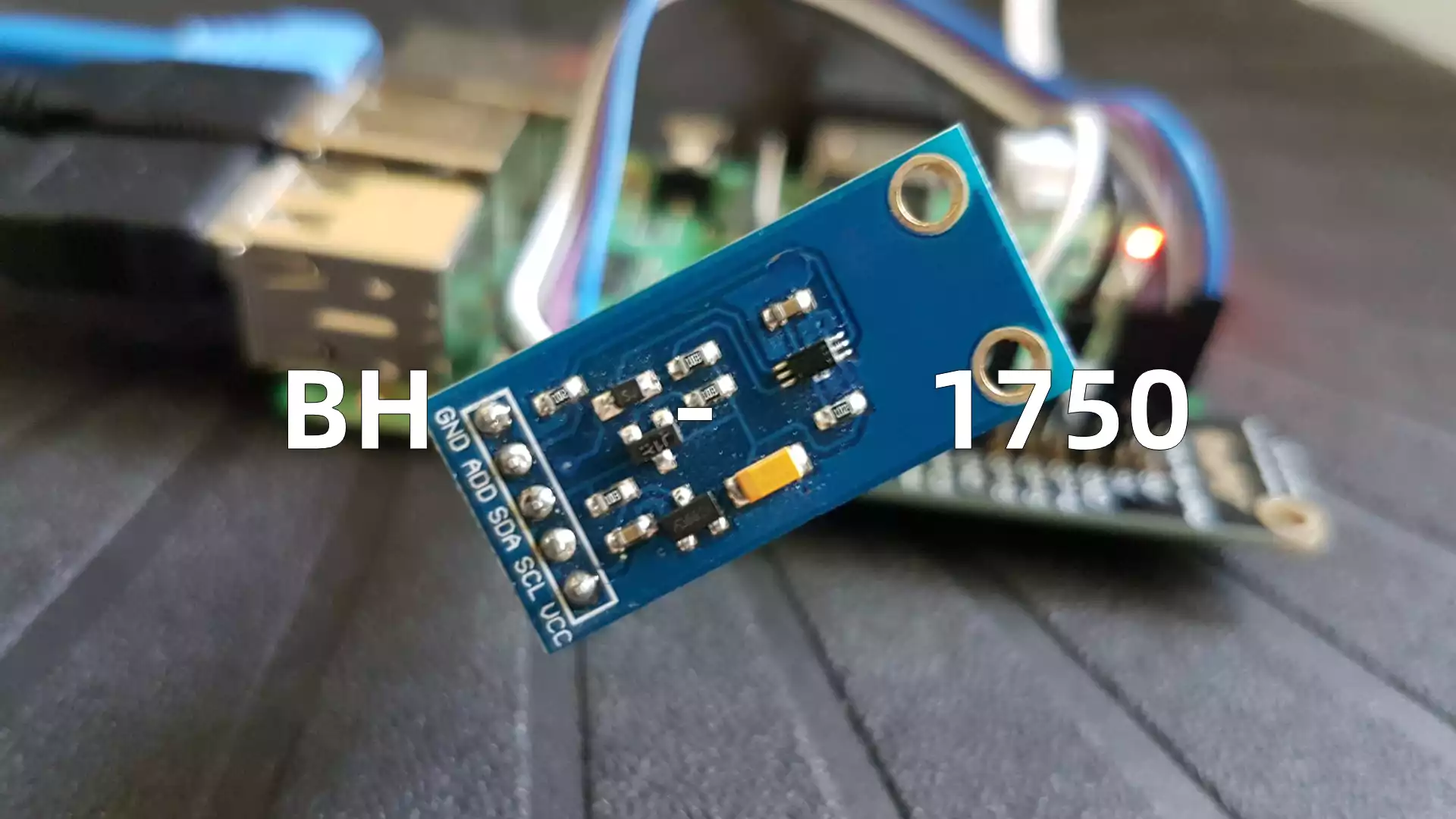前言 最近在写比赛的文档的时候,写到了 BH1750 的参数之类的,于是想着想都想了,不如写下来玩玩。
模块和芯片 而 BH1750 是一款数字型的光强传感器片上集成芯片,采用标准 I2C 总线协议与 MCU 进行链接。
GY-30 模块的实质是 BH1750,只是把外围诸如滤波和电容之类的电路整合进去了而已,其实都是用的 BH1750 芯片。
BH1750 内部电路是由:光敏二极管、运算放大器、AD 转换器等组成。光敏二极管通过光伏效应接收光信号产生电信号,经过运算放大后,由 AD 转换器采集电压数据并转换为数字信号,然后储存在寄存器之中。BH1750 支持完全的 I2C 协议,使用 I2C 总线发送特定的控制位,即可读取光强度数据,亦可以修改 BH1750 的采集模式。
引脚定义 BH1750 支持且仅支持完整的 I2C 总线,采用四线传输方式,但由于 BH1750 模块本身可以从硬件对其设备地址进行修改,所以还多一个修改位。
名称 说明 VCC 接入 3.3V 电源正极 SCL I2C 时钟同步总线 SDA I2C 实际数据总线 ADDR I2C 设备地址切换线;低电平:0x23,高电平:0x5C GND 接地或者电源负极
I2C 协议 前面说到,BH1750 模块支持完整的 I2C 总线协议。I2C 总线是由飞利浦公司推出的串行、半双工总线,它是总线通讯,可以在总线上最高挂载 112 个设备(含保留地址则为 127 个设备)。
I2C 总线是一种多主机总线,连接在 I2C 总线上的器件分为主机和从机。 主机有权发起和结束一次通信,从机只能被动呼叫。每个 I2C 设备有一个唯一的 7bit 地址,由于需要告知从机是读取还是写入,所以在实际使用中会增加一个 bit 作为控制,实际使用中是 8 个 bit 地址。BH1750 的通讯过程
首先我们看数据手册,可以发现 BH1750 的数据收发分为两个 8bit 合共 16 个 bit 的数据(不算 ACK)。数据结构于英文文档之下表如下:
在实际使用中,Slave Address 与 R/W 数据可以一起传输,即 7bit+1bit = 8bit
传输路径跟其他 I2C 设备一样,发送 Slave Address → 等 ACK 应答 → 发送 Opecode 数据 → 等 ACK 应答。
第一步:发送上电指令 (0x01)
假设 ADDR 为低电平,BH1750 设备地址为 0x23 + R0 = 0x46。数据结构为:0x46 WaitACK 0x01 WaitACK
第二步:发送测量模式指令 (0x10)
根据图片上和第一步的例子,我们假定 ADDR 低电平且采用连续 H 分辨率测量的模式(0x10)
数据结构为:0x46 WaitACK 0x10 WaitAC
第三步:等测量和读数据
手册上对每个测量模式的时间有说,连续 H 分辨率需要的时间最长,平均为 120ms,但是为了数据最新,最好是隔 200ms 读取一次。值得一提的是,寄存器数据不会清零,因此亦可以不延迟直接读取,只是有点误差。
现在,是读取模式,与之前的 0x23 + R0 = 0x46 的地址不同,读取模式是 0x23 + W1 = 0x47 的地址。
因此数据结构为:0x47 WaitACK 读出的数据 WaitACK
第四步:计算实际光照值
前面读出来的值,显然的是 BH1750 内部传感器的值,并不是真实的光照强度值,根据手册,我们需要转换一下。
H 模式: 光照强度 = 1 / 1.2 * (寄存器值 [15:0] * 分辨率) 单位是 lx
H2 模式:光照强度 = 1 / 1.2 * (寄存器值 [15:0] * 分辨率) / 2 单位是 lx
BH1750 的指令和测量模式 所有指令 名称 地址 注释 断电 Power Down 0000_0000 无激活状态 No active state. 上电 Power On 0000_0001 通电等待测量指令 Waiting for measurement command. 重置 Reset 0000_0111 重置寄存器的所有值 Reset Data register value. Reset command is not acceptable in Power Down mode. 连续 H 分辨率模式 Continuously H-Resolution Mode 0001_0000 在 1lx 分辨率下开始连续测量 Start measurement at 1lx resolution. Measurement Time is typically 120ms. 连续 H 分辨率模式 2 Continuously H-Resolution Mode2 0001_0001 在 0.5lx 分辨率下开始连续测量 Start measurement at 0.5lx resolution. Measurement Time is typically 120ms. 连续 L 分辨率模式 Continuously L-Resolution Mode 0001_0011 在 4lx 分辨率下开始连续测量 Start measurement at 4lx resolution. Measurement Time is typically 16ms. 一次 H 分辨率模式 One Time H-Resolution Mode 0010_0000 在 1lx 分辨率下开始测量一次,完成后进入断电模式 Start measurement at 1lx resolution. Measurement Time is typically 120ms. It is automatically set to Power Down mode after measurement. 一次 H 分辨率模式 2 One Time H-Resolution Mode2 0010_0001 在 0.5lx 分辨率下开始测量一次,完成后进入断电模式 Start measurement at 0.5lx resolution. Measurement Time is typically 120ms. It is automatically set to Power Down mode after measurement. 一次 L 分辨率模式 One Time L-Resolution Mode 0010_0011 在 4lx 分辨率下开始测量一次,完成后进入断电模式 Start measurement at 4lx resolution. Measurement Time is typically 16ms. It is automatically set to Power Down mode after measurement. Change Measurement time (High bit) 01000_MT[7,6,5] Change measurement time. ※ Please refer “adjust measurement result for influence of optical window.” Change Masurement time (Low bit) 011_MT[4,3,2,1,0] Change measurement time. ※ Please refer “adjust measurement result for influence of optical window.”
各类测量模式 测量模式 精度 测量时间 注释 一次 H 分辨率模式 1 lx 120ms 进行一次测量,测量完成后会切换到断电模式 一次 H 分辨率模式 2 0.5 lx 120ms 进行一次测量,测量完成后会切换到断电模式 一次 L 分辨率模式 4 lx 16ms 进行一次测量,测量完成后会切换到断电模式 连续 H 分辨率模式 1 lx 120ms 会自动进行连续测量,无需重复配置 连续 H 分辨率模式 2 0.5 lx 120ms 会自动进行连续测量,无需重复配置 连续 L 分辨率模式 4 lx 16ms 会自动进行连续测量,无需重复配置
编程和代码部分 下面的编程我以 stm32 为例,I2C 和 BH1750 都是标准协议,其实换成其他单片机或者系统,程序也是基本一样的,不同的只是 GPIO 口的不同。
这边用的就还是软件模拟 I2C 的方式,没有用硬件 I2C。
1. 头文件定义部分 1 2 3 4 5 6 7 8 9 10 11 12 13 14 15 16 17 18 19 20 21 22 23 24 25 26 27 28 29 30 31 32 33 34 35 36 37 38 39 40 #ifndef __BH1750_H__ #define __BH1750_H__ #include "stm32f10x.h" #include "Delay.h" /** * author: 御枫林下 on Tue, 28 May 2024 * brief: 宏定义 GOIO 引脚 * param: void * return: void **/ #define BH1750_I2C_GPIO_Port GPIOB #define BH1750_I2C_SCL_GPIOPin GPIO_Pin_6 #define BH1750_I2C_SDA_GPIOPin GPIO_Pin_7 #define BH1750_I2C_SCL(x) GPIO_WriteBit(BH1750_I2C_GPIO_Port, BH1750_I2C_SCL_GPIOPin, (x)) #define BH1750_I2C_SDA(x) GPIO_WriteBit(BH1750_I2C_GPIO_Port, BH1750_I2C_SDA_GPIOPin, (x)) #define BH1750_I2C_SDARead() GPIO_ReadInputDataBit(BH1750_I2C_GPIO_Port, BH1750_I2C_SDA_GPIOPin) #define HIGH Bit_SET #define LOW Bit_RESET /** * author: 御枫林下 on Tue, 28 May 2024 * brief: 宏定义 BH1750 相关地址 **/ #define BH1750_ADDRESS 0x46 #define BH1750_CMD_AddWrite 0x46 #define BH1750_CMD_AddRead 0x47 #define BH1750_CMD_PowOn 0x01 #define BH1750_CMD_ModeH1 0x10 /** * author: 御枫林下 on Wed, 21 May 2024 * brief: 过滤需要用到的函数 * note: 不在此列的函数,无法在外部调用。为了保证函数在本体的可用性,在源文件内会重新定义一次。 **/ void BH1750_Init(void); uint16_t BH1750_FluxValue(void); uint16_t BH1750_ReadData(void); #endif
2. BH1750 部分 1 2 3 4 5 6 7 8 9 10 11 12 13 14 15 16 17 18 19 20 21 22 23 24 25 26 27 28 29 30 31 32 33 34 35 36 37 38 39 40 41 42 43 44 45 46 47 48 49 50 51 52 53 54 55 56 57 58 59 60 61 62 63 64 65 66 67 68 69 70 71 72 73 74 75 76 77 78 79 80 81 82 83 84 85 86 87 88 89 90 91 92 93 94 95 96 97 98 99 100 101 102 103 104 105 106 107 108 109 110 111 112 113 114 115 116 117 118 119 120 121 122 123 124 125 126 127 128 129 130 131 132 133 134 135 136 137 138 139 140 141 142 143 144 145 146 147 148 149 150 151 152 153 154 155 156 157 158 159 160 161 162 163 164 165 166 167 168 169 170 171 172 173 174 175 176 177 178 179 180 181 #include "BH1750.h" /** * author: 御枫林下 on Wed, 21 May 2024 * brief: 定义所有函数 **/ static void BH1750_I2C_GPIOInit(void); void BH1750_I2C_Start(void); void BH1750_I2C_Stop(void); void BH1750_I2C_SendByte(uint8_t Byte); uint8_t BH1750_I2C_ReadByte(void); uint8_t BH1750_I2C_WaitAck(void); uint16_t BH1750_FluxValue(void); void BH1750_Init(void); /** * author: 御枫林下 on Wed, 21 May 2024 * brief: GPIO 初始化函数 * param: void * return: void **/ static void BH1750_I2C_GPIOInit(void) { RCC_APB2PeriphClockCmd(RCC_APB2Periph_GPIOB, ENABLE); GPIO_InitTypeDef GPIO_InitStructure; GPIO_InitStructure.GPIO_Pin = BH1750_I2C_SCL_GPIOPin | BH1750_I2C_SDA_GPIOPin; GPIO_InitStructure.GPIO_Mode = GPIO_Mode_Out_OD; GPIO_InitStructure.GPIO_Speed = GPIO_Speed_50MHz; GPIO_Init(BH1750_I2C_GPIO_Port, &GPIO_InitStructure); BH1750_I2C_SDA(HIGH); BH1750_I2C_SCL(HIGH); } void BH1750_I2C_Start(void) { BH1750_I2C_SDA(HIGH); BH1750_I2C_SCL(HIGH); Delay_us(10); BH1750_I2C_SDA(LOW); Delay_us(10); BH1750_I2C_SCL(LOW); Delay_us(10); } void BH1750_I2C_Stop(void) { BH1750_I2C_SCL(LOW); BH1750_I2C_SDA(LOW); Delay_us(10); BH1750_I2C_SCL(HIGH); Delay_us(10); BH1750_I2C_SDA(HIGH); Delay_us(10); } void BH1750_I2C_SendByte(uint8_t Byte) { for (uint8_t i = 0; i < 8; i++) { BH1750_I2C_SDA(Byte & (0x80 >> i) ? HIGH : LOW); BH1750_I2C_SCL(HIGH); Delay_us(10); BH1750_I2C_SCL(LOW); Delay_us(10); } } uint8_t BH1750_I2C_ReadByte(void) { uint8_t byte = 0x00; BH1750_I2C_SDA(HIGH); Delay_us(10); for (uint8_t i = 0; i < 8; i++) { BH1750_I2C_SCL(HIGH); Delay_us(10); if (BH1750_I2C_SDARead()) { byte |= (0x80 >> i); } BH1750_I2C_SCL(LOW); Delay_us(10); } return byte; } uint8_t BH1750_I2C_WaitAck(void) { uint8_t AckTag = 0; BH1750_I2C_SDA(HIGH); BH1750_I2C_SCL(HIGH); Delay_us(10); if (BH1750_I2C_SDARead()) { AckTag = 1; } BH1750_I2C_SCL(LOW); Delay_us(10); return AckTag; } void BH1750_I2C_SendAck(void) { BH1750_I2C_SDA(LOW); Delay_us(10); BH1750_I2C_SCL(HIGH); Delay_us(10); BH1750_I2C_SCL(LOW); Delay_us(10); } void BH1750_I2C_SendNAck(void) { BH1750_I2C_SDA(HIGH); Delay_us(10); BH1750_I2C_SCL(HIGH); Delay_us(10); BH1750_I2C_SCL(LOW); Delay_us(10); } uint8_t BH1750_SendData(uint8_t data) { BH1750_I2C_Start(); BH1750_I2C_SendByte(BH1750_CMD_AddWrite); if (BH1750_I2C_WaitAck()) { BH1750_I2C_Stop(); return 1; } BH1750_I2C_SendByte(data); if (BH1750_I2C_WaitAck()) { BH1750_I2C_Stop(); return 2; } BH1750_I2C_Stop(); return 0; } uint16_t BH1750_ReadData(void) { uint8_t MSB, LSB; BH1750_I2C_Start(); BH1750_I2C_SendByte(BH1750_CMD_AddRead); if (BH1750_I2C_WaitAck()) { BH1750_I2C_Stop(); return 0; } MSB = BH1750_I2C_ReadByte(); BH1750_I2C_SendAck(); LSB = BH1750_I2C_ReadByte(); BH1750_I2C_SendNAck(); BH1750_I2C_Stop(); return (MSB << 8) | LSB; } /** * author: 御枫林下 on Wed, 21 May 2024 * brief: BH1750 读取并转换光照值函数 * param: void * return: float temp 返回 Flux 单位的光照值 * note: 需要先调用 BH1750_Init() 函数初始化整个 BH1750 后,才能调用. **/ uint16_t BH1750_FluxValue(void) { uint16_t temp = 0; uint16_t raw_data = BH1750_ReadData(); temp = raw_data / 1.2; return temp; } void BH1750_Init(void) { BH1750_I2C_GPIOInit(); BH1750_SendData(BH1750_CMD_PowOn); BH1750_SendData(BH1750_CMD_ModeH1); }
3. Delay 函数 1 2 3 4 5 6 7 8 9 10 11 12 13 14 15 16 17 18 19 20 21 22 23 24 25 26 27 28 29 30 31 32 33 34 35 36 37 38 39 #include "Delay.h" /** * @brief 微秒级延时 * @param xus 延时时长,范围:0~233015 * @retval 无 */ void Delay_us(uint32_t xus) { SysTick->LOAD = 72 * xus; // 设置定时器重装值 SysTick->VAL = 0x00; // 清空当前计数值 SysTick->CTRL = 0x00000005; // 设置时钟源为 HCLK,启动定时器 while(!(SysTick->CTRL & 0x00010000)); // 等待计数到 0 SysTick->CTRL = 0x00000004; // 关闭定时器 } /** * @brief 毫秒级延时 * @param xms 延时时长,范围:0~4294967295 * @retval 无 */ void Delay_ms(uint32_t xms) { while(xms--) { Delay_us(1000); } } /** * @brief 秒级延时 * @param xs 延时时长,范围:0~4294967295 * @retval 无 */ void Delay_s(uint32_t xs) { while(xs--) { Delay_ms(1000); } }
4. 主函数 1 2 3 4 5 6 7 8 9 10 11 12 13 14 15 #include "stm32f10x.h" // Device header #include "USART1.h" #include "BH1750.h" int main() { USART1_Init(); BH1750_Init(); while(1) { USART1_Printf("BH1750: %d \r", BH1750_FluxValue()); Delay_ms(500); } }
读取的时候直接调用 BH1750_FluxValue() 函数即可以直接读取出数值。






